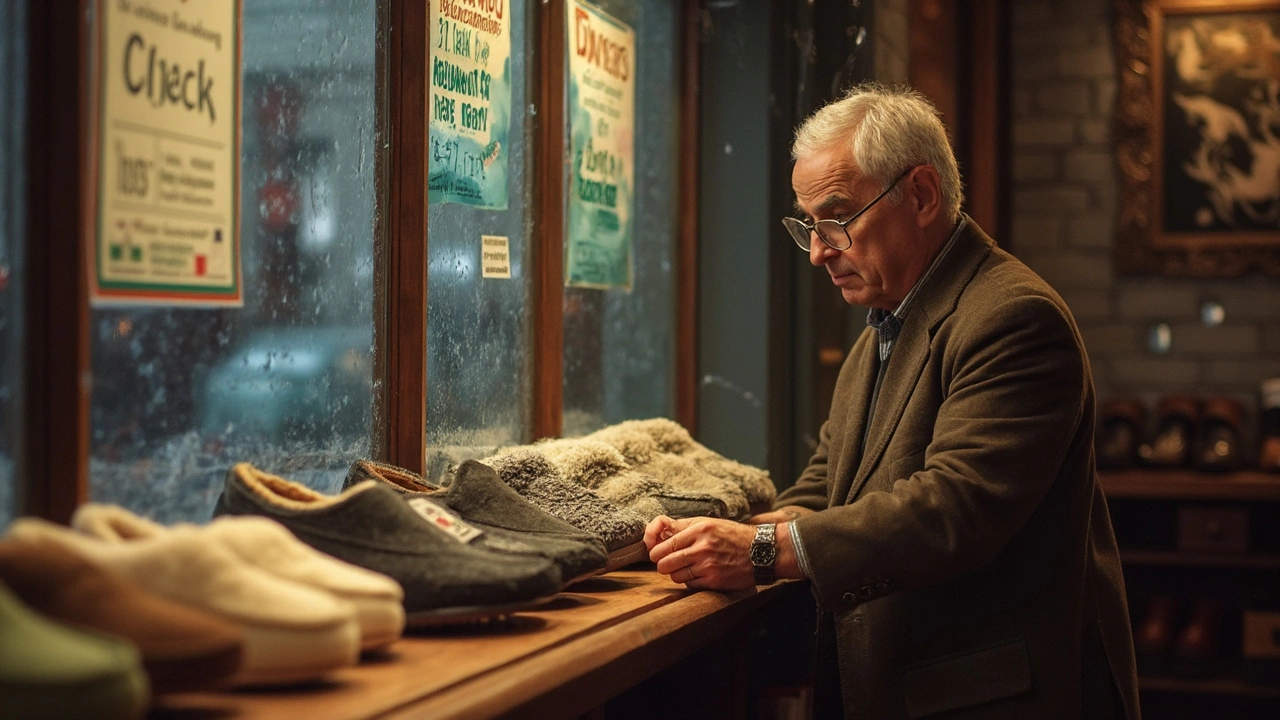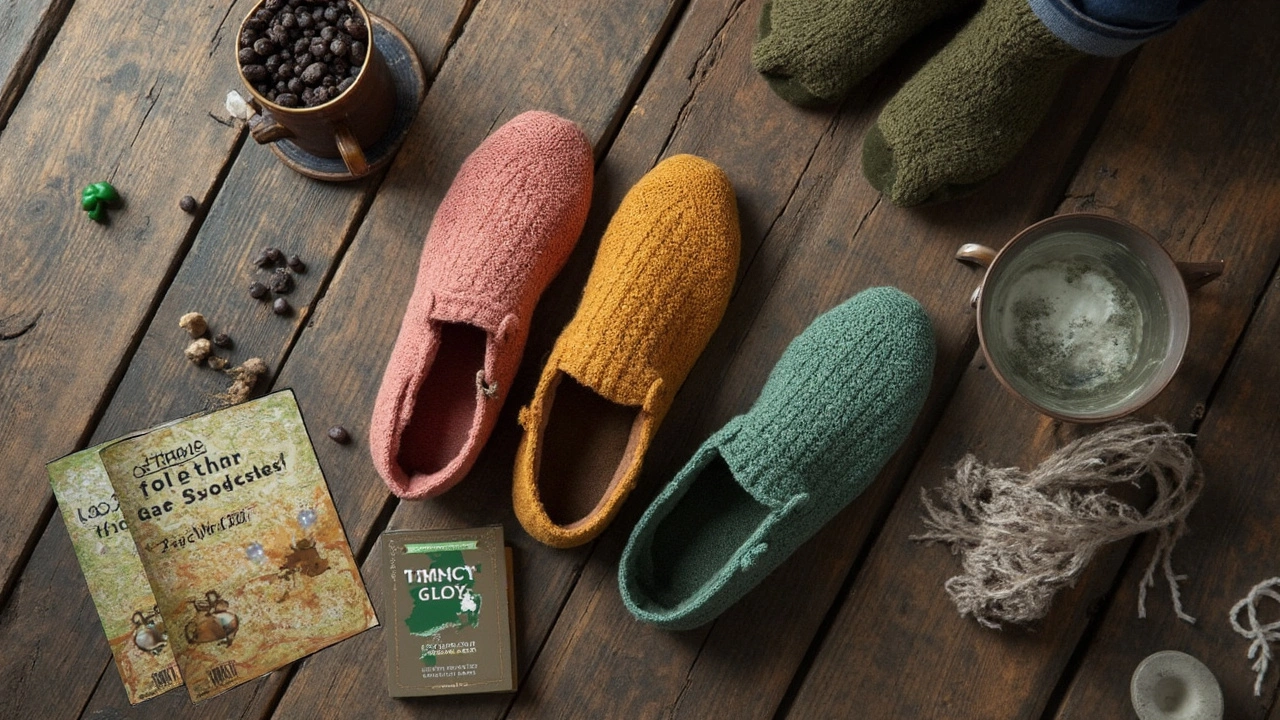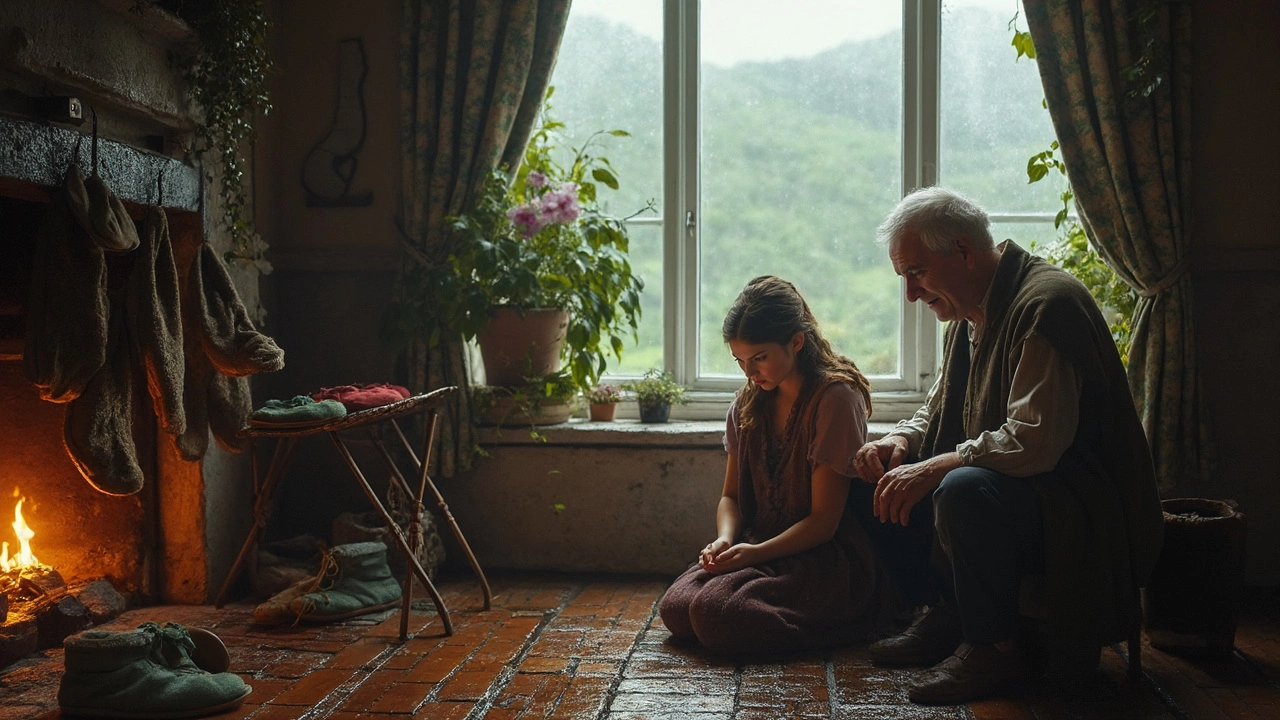Walk into any house in Ireland and you’ll spot a pair of slippers by the door. The weather here just does something to your feet—especially when April showers show up half the year. Keeping a good pair of slippers isn’t just about comfort; in Irish homes, it’s almost a tradition.
You might shrug off that hole in the sole or the worn-out heel, but holding onto battered slippers can actually make chilly floors feel even colder. Ever noticed the draft in an older house in Dublin, Galway, or Cork? Trust me, a decent pair of slippers becomes your best mate pretty fast.
So how do you know it’s time to swap the old pair for something new? It’s not just a style upgrade. Watch for smooth bottoms, fraying seams, or a smell that just won’t leave. In Ireland’s damp climate, when slippers lose their grip or get soggy, they can get seriously slippery or trap odours. That’s when they stop working as they should—no matter how attached you are.
- Irish Homes: The Essential Role of Slippers
- Spotting Wear and Tear—When Are Your Slippers Done?
- Best Times and Places to Buy in Ireland
- Choosing the Right Pair: Material and Local Brands
- Caring for Your Slippers So They Last
Irish Homes: The Essential Role of Slippers
There’s a reason most people in Ireland have slippers ready by the front door. It isn’t just about comfort—it’s pure practicality. Irish floors can be freezing, especially in older houses with stone tiles or wooden boards. Even in new builds, the damp chill seems to sneak up from the ground, especially during those long Atlantic winters.
In Irish households, slipping off your soggy shoes the minute you step in and sliding into something warm is an unwritten rule. If you stay with friends in Sligo or Donegal, you’ll probably be offered a spare pair. Don’t be surprised—it's just normal Irish hospitality.
With energy bills on the rise, especially over the past couple of years, people get serious about keeping warm. It’s way cheaper to put on cozy footwear than to crank up the heat all day. A survey by Bord Gáis Energy found that 67% of Irish adults try to wear extra layers—including slippers—before touching the thermostat. Every little bit helps when it comes to saving on electric and gas in Ireland.
- Many Irish schools and creches encourage kids to bring indoor slippers—makes the classroom less muddy and keeps everyone healthier.
- Plumbers will tell you: cold floors can cause more than just chilly toes. Prolonged exposure can worsen joint pain or creaky knees, especially if you’ve got arthritis.
- Some popular Irish brands, like Dubarry and SlumberSlips, actually make slippers that handle the wet climate and last longer than cheap high-street pairs.
So, in Ireland, buying new slippers isn’t just a comfort thing. It’s part of everyday life, from keeping floors clean to making sure you’re toasty on damp winter evenings.
Spotting Wear and Tear—When Are Your Slippers Done?
You know that moment when your slippers Ireland style start to look like they’ve survived a few too many wet mornings? It’s easy to keep putting off buying new ones, but holding onto slippers that are past their best isn’t doing your comfort—or safety—any favours.
First things first: check the soles. If they’re smooth as butter and have lost their grip, that’s a slip hazard, especially on slick tiles you find in many Irish kitchens and bathrooms. People in older Dublin terraces and rural homes with flagstone floors know this struggle all too well. If you’re sliding more inside than you do out on a rainy Limerick street, it’s time for an upgrade.
Next, pay attention to the fabric and seams. Are the insides thinning or flattened down, leaving your feet basically on the floor? Are the seams bursting open or holding a permanent damp smell even after a wash? With the Irish air being so humid, slippers can hang onto musty smells and even develop mildew. That’s not just unpleasant—it’s no good for your health.
- If the sole bends completely in half with no resistance, the support is gone.
- Look for frayed stitching, loose linings, or holes—these only get worse with time and can let drafts in.
- If you’ve needed to wash your slippers often because of Ireland’s muddy winters, remember that frequent washing breaks down fabric fast, so keep an eye out for wear after every cycle.
And don’t forget about odour. Even the best cozy footwear gets smelly after constant use, especially if you’re wearing them daily to stay warm on cold Wicklow mornings. If the smell lingers after a wash, that’s a sign bacteria have moved in for good.
Here’s a quick table you can use to judge whether your slippers are still doing their job or holding you back:
| Sign | Time to Replace? |
|---|---|
| Slick or flattened soles | Yes |
| Obvious holes or split seams | Yes |
| Musty or stubborn smell | Yes |
| Floppy, no support | Yes |
| Still comfy, no odour, no damage | No |
When you spot any of these warning signs, do yourself a favour—start browsing for new slippers Ireland style before the next cold spell rolls in. Your toes will thank you, especially when that classic County Kerry chill hits your floors.

Best Times and Places to Buy in Ireland
Snagging great slippers Ireland offers is easier than you think, if you know where and when to look. Most people in Ireland go shopping for slippers around October, just as the first real chill settles in. But don’t wait for everyone else to rush in—stock flies off shelves at that time. If you prefer more choice and better deals, target back-to-school sales in August and big winter promos around Black Friday and post-Christmas sales. These are the sweet spots for both price and selection.
When picking a shop, think local. Dunnes Stores and Penneys (Primark) are go-tos for affordable basics, and they often update styles with each season. Want something a bit fancier or made to last? Check out Slippers.ie—an Irish online shop that only focuses on cozy footwear for our weather. Or, go for local makers at the Kilkenny Shop for handmade luxury. If you’re in Dublin, Arnotts always has a decent selection, and their staff know their stuff.
"Don’t wait for holes to show up before you buy new slippers – the damp in Ireland can spoil them long before you see the damage,” says Fiona O’Leary, footwear buyer for a leading Irish department store.
If you’re bargain-hunting, keep an eye on Lidl and Aldi. They do occasional ‘Middle Aisle’ deals, where you can scoop up surprisingly strong slippers for the price of a couple of coffees. Just act fast; those bins empty within days.
Your choices online are even broader. Irish retailers like Lifestyle Sports or Elverys run discounts especially in late summer and after Christmas. Here’s a quick look at popular times when deals pop up:
| Period | Typical Discount | Popular Stores |
|---|---|---|
| August – Back to School | Up to 25% | Dunnes, Penneys |
| Black Friday (November) | 20–40% | Slippers.ie, Arnotts |
| Post-Christmas | 30% and up | Kilkenny Shop, Online Retailers |
No matter where you buy, make sure you try your slippers on with socks—or at least check the return policy if you’re shopping online. Irish weather means your feet will swell (or shrink) more with the seasons than you think, so that perfect fit in July could be snug come January.
Choosing the Right Pair: Material and Local Brands
Picking out new slippers in Ireland is more than grabbing any old pair from the shop. The typical Irish house battles with damp floors and chilly draughts, so the right material matters. Wool and felt are the two standouts here—they dry fast, keep feet warm, and won’t stink up after a wet walk to the bins. Slippers with a sturdy rubber sole add a layer of protection, especially if you’re stepping out for the post or popping down a cold hallway.
If you want slippers that’ll see you through a winter in Sligo or a Sunday morning in Kerry, look for these winning features:
- Memory foam or cushioned insoles for support—this helps if you’re on your feet making tea for half the family.
- Breathe-easy materials like wool, sheepskin, or fleece—these fight off that musty smell after a soggy day.
- Non-slip rubber soles—absolutely needed if you’ve got tiled or timber floors common in Irish homes.
- Easy to wash—handy for cleaning up after that surprise splash of Barry’s tea.
Irish shops offer a fair few solid brands that know how to handle the worst of Irish weather. Brands like Dubarry and Clarks (often found in Arnotts or Brown Thomas) are favourites for their build quality. Penneys (Primark outside Ireland) brings budget options, but check the material before you buy—sometimes the cheaper pairs won’t last a full winter. If you want to shop local, check out places like the Irish Socksciety, which collaborates with Galway crafters on quirky, hard-wearing pairs.
Here’s a quick look at popular slipper materials for Irish homes and how they perform:
| Material | Warmth | Drying Speed | Odour Control |
|---|---|---|---|
| Wool | High | Fast | Good |
| Sheepskin | Very High | Medium | Excellent |
| Fleece | Medium | Fast | Fair |
| Synthetic | Low-Medium | Fast | Poor |
If you want slippers for popping out to the bins or garden, check for waterproof soles. Dublin’s drizzle doesn’t care about your toes, so don’t skimp. For the best value, hit sales in October or January. Most Irish retailers drop prices right before and after the Christmas rush. That’s when you can get quality cozy footwear without paying over the odds.

Caring for Your Slippers So They Last
Slippers might seem easygoing, but if you want them to stay comfy through Irish winters, you’ve got to look after them. The mix of wet weather and wooden floors here can be tough on even the sturdiest pair. A few minutes now and then can mean you don’t have to hit the shops for slippers Ireland style any more than necessary.
First off, always check the label. Wool slippers (like those from Donegal or Galway shops) usually don’t like hot water. Leather pairs, popular for their hardiness, hate soaking. If you’re rocking something from an Irish brand like Slippers.ie, most say a quick spot clean is enough. In general, here’s what keeps them in good nick:
- Air them out: Even when it’s raining, leaving slippers by a window after a day’s wear stops dampness and keeps the musty smell away. This is crucial in towns where the air rarely gets really dry.
- Hand wash if you can: Most people in Ireland hand-wash their slippers in cool water with a bit of gentle soap. Don’t soak them—just scrub dirty spots and let them dry naturally. Radiators seem tempting but can warp shapes or ruin memory foam insoles.
- Use slipper sprays or inserts: You’ll find deodorising sprays and anti-bacterial inserts in chemists across Ireland. A quick spritz keeps things fresh, especially in a damp climate where odour can build up fast.
- Patch small holes: Before tossing them, slap a patch on minor rips or burst seams. A simple needle and thread job extends the life of your favourites, especially if you’re attached to a specific pair from last year’s Brown Thomas Christmas sale.
- Store them smart: When not in use (say, during a rare Irish heatwave), keep slippers off cold concrete or damp areas. Use a basket or pop them in an old pillowcase. This keeps them dust-free and less likely to collect unwanted visitors like moths.
If you ever wondered how quickly slippers can wear out, check out the table below. These are average lifespans for common types of cozy footwear used in Irish homes, based on local shop data and product recommendations:
| Type of Slipper | Expected Lifespan (Daily Use) |
|---|---|
| Fleece Lined | 6-9 months |
| Wool (Irish brands) | 12-18 months |
| Leather | 18-24 months |
| Foam Sole | 4-6 months |
It doesn’t take loads of effort, but these simple steps will keep your slippers Ireland ready for cozy nights for ages—no need to reach for a new pair at every sign of rain.
